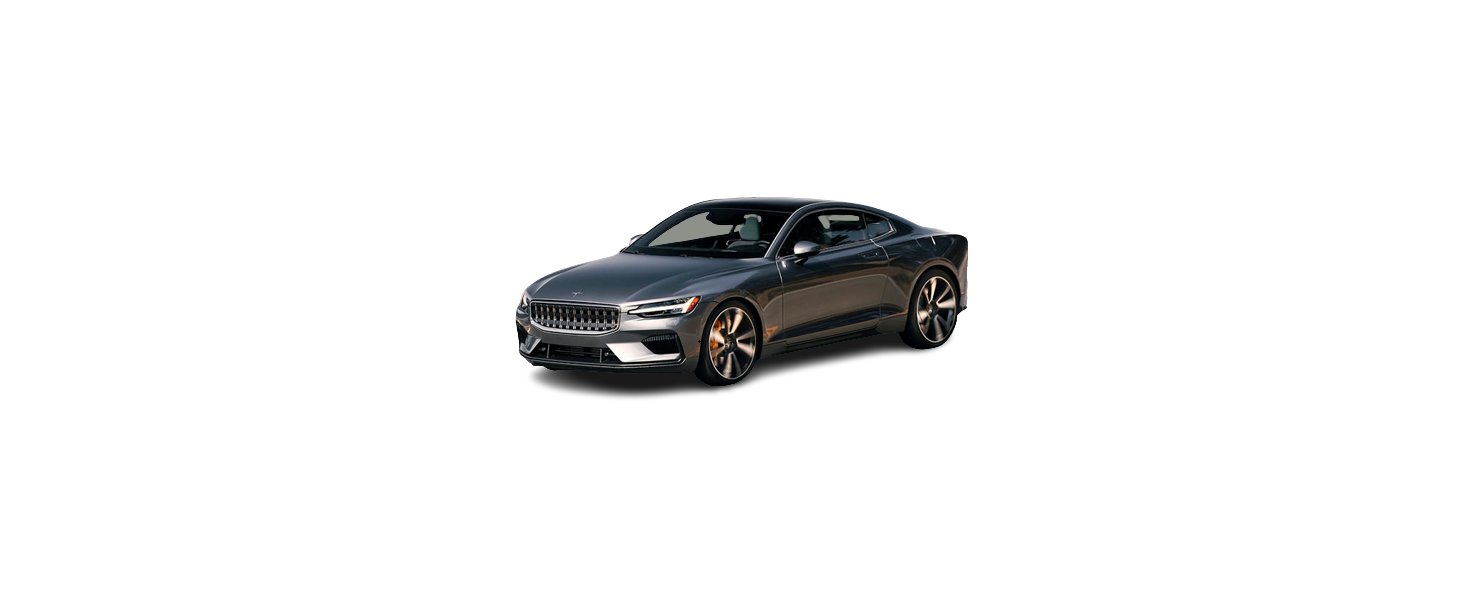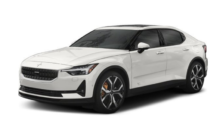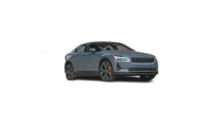



2021 Polestar 1 Child safety



Booster cushions
Suitable child restraints should always be used when children (depending on their age/size) are seated in the vehicle.
Securing a booster cushion
WARNING
Only children up to 125 cm (4 feet 1 inch) may ride in the rear seat in a child restraint.




PS-1926-USA-booster cushion
Position the child correctly on the booster cushion.
Booster cushions are recommended for children who have outgrown convertible seats.
- Place the booster cushion in the rear seat of the vehicle.
- With the child properly seated on the booster cushion, attach the seat belt to or around the cushion according to the manufacturer’s instructions.
- Fasten the seat belt by inserting the latch plate into the buckle (lock) until a distinct click is audible.


PS-1926-USA-booster cushion 2
Positioning the seat belt.
Ensure that the seat belt is pulled taut and fits snugly around the child.
WARNING
- The hip section of the three-point seat belt must fit snugly across the child’s hips, not across the stomach.
- The shoulder section of the three-point seat belt should be positioned across the chest and shoulder.
- The shoulder belt must never be placed behind the child’s back or under the arm.
Child restraints
Suitable child restraints should always be used when children travel in the vehicle.
Child restraint systems


PS-1926-USA-infant seat
Infant seat
There are three main types of child restraint systems: infant seats, convertible seats and booster cushions. They are classified according to the child’s age and size.
The child restraint should be secured using a three-point seat belt, ISOFIX/LATCH anchors, top tether anchors, or a combination of one or more of the above. Always follow the instructions of the child restraint manufacturer.

PS-1926-USA-convertible seat 2
Convertible seat
WARNING
A child seat should never be used in the front passenger seat of any vehicle with a front passenger airbag – not even if the “Passenger airbag off” symbol near the rear-view mirror is illuminated. If the severity of an accident were to cause the airbag to inflate, this could lead to serious injury or death to a child seated in this position.

PS-1926-USA-booster cushion
Booster cushion
WARNING
Always refer to the child restraint manufacturer’s instructions for detailed information on securing the restraint.
WARNING
When not in use, keep the child restraint system secured or remove it from the passenger compartment to help prevent it from injuring passengers in the event of a sudden stop or collision.
A small child’s head represents a considerable part of its total weight and its neck is still very weak. Polestar recommends that children up to age 4 travel, properly restrained, facing rearward. In addition, Polestar recommends that children should ride facing rearward, properly restrained, as long as possible.
NOTE
Prolonged installation and use of child restraints may damage the vehicle’s interior.
Automatic Locking Retractor/Emergency Locking Retractor (ALR/ELR)
To make child seat installation easier, each seat belt (except for the driver’s belt) is equipped with a locking mechanism to help keep the seat belt taut.
When attaching the seat belt to a child seat:
- Position the child seat and secure it using the seat belt according to the instructions from the manufacturer.
- Pull the seat belt out as far as possible.
- Insert the seat belt latch plate into the buckle (lock) in the usual way.
- Release the seat belt and pull it taut around the child seat.
- A sound from the seat belt retractor will be audible at this time and is normal. The belt will now be locked in place. This function is automatically disabled when the seat belt is unlocked and the belt is fully retracted.
WARNING
Do not use child safety seats or child booster cushions/backrests in the front passenger’s seat. We also recommend that children who have outgrown these devices sit in the rear seat with the seat belt properly fastened.
Child restraint registration and recalls
Child restraints could be recalled for safety reasons. You must register your child restraint to be reached in a recall. To stay informed about child safety seat recalls, be sure to fill out and return the registration card that comes with new child restraints.
Child restraint recall information is readily available in both the U.S. and Canada. Information on recalls in the United States is obtained from the government’s customer center for vehicle safety at phone number 1-800-424-9393 or at https://www-odi.nhtsa.dot.gov/owners/SearchSafetyIssues. In Canada, visit the website for child safety at Transport Canada at https://www.tc.gc.ca/en/services/road/child-car-seat-safety.html.
Child safety
Children should always be seated safely when traveling in the vehicle.
General information
Polestar recommends the proper use of restraint systems for all occupants including children. Remember that, regardless of age and size, a child should always be properly restrained in a vehicle.
Your vehicle is also equipped with ISOFIX/LATCH attachments, which make it more convenient to install child seats.
Some restraint systems for children are designed to be secured in the vehicle by lap belts or the lap portion of a lap-shoulder belt. Such child restraint systems can help protect children in vehicles in the event of an accident only if they are used properly. However, children could be endangered in a crash if the child restraints are not properly secured in the vehicle. Failure to follow the installation instructions for your child restraint can result in your child striking the vehicle’s interior in a sudden stop.
Holding a child in your arms is NOT a suitable substitute for a child restraint system. In an accident, a child held in a person’s arms can be crushed between the vehicle’s interior and an unrestrained person. The child could also be injured by striking the interior, or by being ejected from the vehicle during a sudden maneuver or impact. The same can also happen if the infant or child rides unrestrained on the seat. Other occupants should also be properly restrained to help reduce the chance of injuring or increasing the injury of a child.
All states and provinces have legislation governing how and where children should be carried in a vehicle. Find out the regulations existing in your state or province. Recent accident statistics have shown that children are safer in rear seating positions than front seating positions when properly restrained. A child restraint system can help protect a child in a vehicle. Here’s what to look for when selecting a child restraint system:
It should have a label certifying that it meets applicable Federal Motor Vehicle Safety Standards (FMVSS 213) – or in Canada, CMVSS 213.
Make sure the child restraint system is approved for the child’s height, weight and development – the label required by the standard or regulation, or instructions for infant restraints, typically provide this information.
In using any child restraint system, we urge you to carefully look over the instructions that are provided with the restraint. Be sure you understand them and can use the device properly and safely in this vehicle. A misused child restraint system can result in increased injuries for both the infant or child and other occupants in the vehicle.
When a child has outgrown the child safety seat, you should use the rear seat with the standard seat belt fastened. The best way to help protect the child here is to place the child on a booster cushion so that the seat belt is properly positioned across the hips and shoulders. Legislation in your state or province may mandate the use of a child seat or cushion in combination with the seat belt, depending on the child’s age and/or size. Please check local regulations.

PS-1926-Safety–Child seat and airbag
WARNING
- Do not use child safety seats or child booster cushions/backrests in the front passenger’s seat. We also recommend that children under 140 cm (4 feet 7 inches) in height who have outgrown these devices sit in the rear seat with the seat belt fastened.
- Keep vehicle doors and trunk locked and keep remote controls out of a child’s reach. Unsupervised children could lock themselves in an open trunk and risk injury. Children should be taught not to play in vehicles.
- On hot days, the temperature in the vehicle interior can rise very quickly. Exposure to these high temperatures for even a short period of time can cause heat-related injury or death. Small children are particularly at risk. Never leave children unattended in a vehicle.
WARNING
Only children up to 125 cm (4 feet 1 inch) may ride in the rear seat in a child restraint.
Child seats should always be registered.
Polestar’s recommendations
Why does Polestar believe that no child should sit in the front seat of a vehicle? It’s quite simple really. A front airbag is a very powerful device designed, by law, to help protect an adult.
Because of the size of the airbag and its speed of inflation, a child should never be placed in the front seat, even if he or she is properly belted or strapped into a child safety seat. Please remember to put your children in the back seat, and buckle them up.
WARNING
A child restraint should never be reused if:
- The vehicle has been involved in a collision, no matter how minor
- Its history is unknown
- It is older than the manufacturer’s expiration date
Polestar has some very specific recommendations
- Always wear your seat belt.
- Airbags are a SUPPLEMENTAL safety device which, when used with a three-point seat belt can help reduce serious injuries during certain types of accidents. Polestar recommends that you do not disconnect the airbag system in your vehicle.
- Polestar strongly recommends that everyone in the vehicle be properly restrained.
- Polestar follows NHTSA’s recommendations and recommends that ALL children up to and including 12 years of age sit in the rear seat. This is very strongly recommended for children sitting in rear-facing child seats.
- Drive safely!
Convertible seats
Suitable child restraints should always be used when children (depending on their age/size) are seated in the vehicle.
Securing a convertible seat with a seat belt


PS-1926-USA-convertible seat 1
Do not place the convertible seat in the front passenger’s seat.
Convertible seats can be used in either a forward or rearward-facing position, depending on the age and size of the child.

PS-1926-USA-convertible seat 2
Route the seat belt through the convertible seat.
WARNING
Always use a convertible seat that is suitable for the child’s age and size. See the convertible seat manufacturer’s recommendations.
Place the convertible seat in the rear seat of the vehicle.
WARNING
- A small child’s head represents a considerable part of its total weight and its neck is still very weak. Polestar recommends that children up to age 4 travel, properly restrained, facing rearward. In addition,
- Polestar recommends that children should ride facing rearward, properly restrained, as long as possible.
- Convertible child seats should be installed in the rear seat only.
- A rear-facing convertible seat should not be positioned behind the driver’s seat unless there is adequate space for safe installation.
- Attach the seat belt to the convertible seat according to the child restraint manufacturer’s instructions.


PS-1926-USA-convertible seat 3
- Fasten the seat belt.
- Fasten the seat belt by inserting the latch plate into the buckle (lock) until a distinct click is audible.
- Pull the shoulder section of the seat belt out as far as possible to activate the belt’s automatic locking function.
NOTE
- The locking retractor will automatically release when the seat belt is unbuckled and allowed to retract fully.
- Press the convertible seat firmly in place, let the seat belt retract and pull it taut. A sound from the seat belt retractor’s automatic locking function will be audible at this time and is normal. The seat belt should now be locked in place.


- PS-1926-USA-convertible seat 4 Pull out the shoulder section of the seat belt.
- Push and pull the convertible seat along the seat belt path to ensure that it is held securely in place by the seat belt.
WARNING
It should not be possible to move the child restraint more than 2.5 cm (1 in.) in any direction along the seat belt path.
The convertible seat can be removed by unbuckling the seat belt and letting it retract completely.

PS-1926-USA-convertible seat 5
Ensure that the convertible seat is securely in place.
WARNING
A child seat should never be used in the front passenger seat of any vehicle with a front passenger airbag – not even if the “Passenger airbag off” symbol near the rear-view mirror is illuminated. If the severity of an accident were to cause the airbag to inflate, this could lead to serious injury or death to a child seated in this position.
Infant seats
Suitable child restraints should always be used when children (depending on their age/size) are seated in the vehicle.
Securing an infant seat with a seat belt

- Place the infant seat in the rear seat of the vehicle.
- Attach the seat belt to the infant seat according to the child restraint manufacturer’s instructions.


WARNING
- An infant seat must be in the rear-facing position only.
- The infant seat should not be positioned behind the driver’s seat unless there is adequate space for safe installation.
- Pull the shoulder section of the seat belt out as far as possible to activate the belt’s automatic locking function.
NOTE
The locking retractor will automatically release when the seat belt is unbuckled and allowed to retract fully.
- Press the infant seat firmly in place, let the seat belt retract and pull it taut. A sound from the seat belt retractor’s automatic locking function will be audible at this time and is normal. The seat belt should now be locked in place.


- Check that the infant seat is properly secured.
- Press and pull the infant seat along the direction of the seat belt to check that it is properly held in place by the seat belt.
WARNING
- It should not be possible to move the child restraint more than 2.5 cm (1 in.) in any direction along the seat belt path.


- When installing infant seats in the rear seat, Polestar recommends maintaining a distance of at least 50 mm (2 inches) from the front-most part of the infant seat to the rearmost part of the seat in front.
- The infant seat can be removed by unbuckling the seat belt and letting it retract completely.
Occupant weight sensor
The Occupant Weight Sensor (OWS) is designed to meet the regulatory requirements of Federal Motor Vehicle Safety Standard (FMVSS) 208 and is designed to disable (will not inflate) the passenger’s side front airbag under certain conditions.


Disabling the passenger’s side front airbagPolestar recommends that all occupants (adults and children) shorter than 140 cm (4 feet 7 inches) be seated in the rear seat of any vehicle with a front passenger side airbag and be properly restrained for their size and weight.
The OWS works with sensors that are part of the front passenger’s seat and seat belt. The sensors are designed to detect the presence of a properly seated occupant and determine if the passenger’s side front airbag should be enabled (may inflate) or disabled (will not inflate).
The OWS will disable (will not inflate) the passenger’s side front airbag when:
- the front passenger’s seat is unoccupied, or has small/medium objects in the front seat,
- the system determines that an infant is present in a rear-facing infant seat that is installed according to the manufacturer’s instructions,
- the system determines that a small child is present in a forward-facing child restraint that is installed according to the manufacturer’s instructions,
- the system determines that a small child is present in a booster seat,
- a child or a small person occupies the front passenger’s seat.
The OWS uses a PASSENGER AIRBAG OFF indicator lamp which will illuminate and stay on to remind you that the passenger’s side front airbag is disabled. The PASSENGER AIRBAG OFF indicator lamp is located in the overhead console, near the base of the rearview mirror.
NOTE
When the ignition is switched on, the OWS indicator light will illuminate for several seconds while the system performs a self-diagnostic test.
However, if a fault is detected in the system:
- The OWS indicator light will stay on
- The SRS warning light will come on and stay on and a text message will be displayed.
WARNING
If a fault in the system is detected and indicated as described, be aware that the passenger’s side front airbag will not deploy in the event of a collision. In this case, the SRS system and Occupant Weight Sensor should be inspected by a trained and qualified service technician as soon as possible.
WARNING
- Never try to open, remove or repair any components in the OWS system. This could cause the system to malfunction. Maintenance or repairs should only be carried out by a trained and qualified service technician.
- The front passenger’s seat should not be modified in any way. This could reduce pressure on the seat cushion, which might interfere with the OWS system’s function.
| Passenger’s seat occupancy status | OWS indicator light status | Passenger’s side front airbag status |
| Seat unoccupied | OWS indicator light lights up | Passenger’s side front airbag disabled |
| Seat occupied by low weight occupant/object | OWS indicator light lights up | Passenger’s side front airbag disabled |
| Seat occupied by heavy occupant/object | OWS indicator light is not lit | Passenger’s side front airbag enabled |
The OWS is designed to enable (may inflate) the passenger’s side front airbag in the event of a collision anytime the system senses that a person of adult size is sitting properly in the front passenger’s seat. The PASSENGER AIRBAG OFF indicator lamp will be off and remain off.
If a person of adult size is sitting in the front passenger’s seat, but the PASSENGER AIRBAG OFF indicator lamp is on, it is possible that the person isn’t sitting properly in the seat. If this happens:
- Turn the vehicle off and ask the person to place the backrest in an upright position.
- Have the person sit upright in the seat, centered on the seat cushion, with the person’s legs comfortably extended.
- Restart the vehicle and have the person remain in this position for about two minutes. This will allow the system to detect that person and enable the passenger’s frontal airbag.
- If the PASSENGER AIRBAG OFF indicator lamp remains on even after this, the person should be advised to ride in the rear seat.
This indicates limitations in OWS classification capability. It does not indicate OWS malfunction.
Modifications
If you are considering modifying your vehicle in any way to accommodate a disability, for example by altering or adapting the driver’s or front passenger’s seat(s) and/or airbag systems, please contact Polestar Customer Support or:
In the USA:
Polestar Automotive USA Inc.
Customer Care Center
1 Volvo Drive
P.O. Box 914
Rockleigh, New Jersey 07647
1-800-806-2504
www.polestar.com/us
In Canada:
Polestar Automotive Canada Inc.
9130 Leslie Street, Suite 101
Richmond Hill, ON L4B 0B9
1-800-806-2507
www.polestar.com/ca
WARNING
- No objects that add to the total weight on the seat should be placed on the front passenger’s seat. If a child is seated in the front passenger’s seat with any additional weight, this extra weight could cause the OWS system to enable the airbag, which might cause it to deploy in the event of a collision, thereby injuring the child.
- The seat belt should never be wrapped around an object on the front passenger’s seat. This could interfere with the OWS system’s function.
- The front passenger’s seat belt should never be used in a way that exerts more pressure on the passenger than normal. This could increase the pressure exerted on the weight sensor by a child, and could result in the airbag being enabled, which might cause it to deploy in the event of a collision, thereby injuring the child.
WARNING
- Keep the following points in mind with respect to the OWS system. Failure to follow these instructions could adversely affect the system’s function and result in serious injury to the occupant of the front passenger’s seat:
- The full weight of the front seat passenger should always be on the seat cushion. The passenger should never lift him/herself off the seat cushion using the armrest in the door or the center console, by pressing the feet on the floor, by sitting on the edge of the seat cushion, or by pressing against the backrest in a way that reduces pressure on the seat cushion. This could cause OWS to disable the front, passenger’s side airbag.
WARNING
- Do not place any type of object on the front passenger’s seat in such a way that jamming, pressing, or squeezing occurs between the object and the front seat, other than as a direct result of the correct use of the Automatic Locking Retractor/Emergency Locking Retractor (ALR/ELR) seat belt.
- No objects should be placed under the front passenger’s seat. This could interfere with the OWS system’s function.






